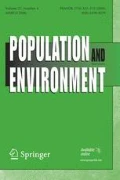Abstract
Palawan Island contains the largest remaining expanse of unbroken forest cover in the Philippines. The forest is currently threatened by agricultural colonization, as numerous migrants from throughout the Philippines settle annually in the island's forested uplands. Further, Palawan is being heavily logged and is, in consequence, the focus of an acrimonious national environmental debate. This paper examines how land alienation and other forms of socioeconomic marginalization attending these pressures have undermined the well-being of Palawan's indigenous tribal peoples. It also explains how lack of secure tenure and failure to achieve popular participation so distort the gap between the ideal and the practice of agroforestry programs aimed at these peoples that such programs not only fail to ameliorate the ecological situation but further undermine tribal well-being.
Similar content being viewed by others
References
Adams, R. N. (1974). Harnessing technological development. In J. J. Poggie and R. M. Lynch (Eds.).Rethinking modernization (pp. 37–68). Westport: Greenwood Press.
Anderson, J. N. (1987). Land at risk people at risk: Perspectives on tropical forest transformation in the Philippines. In P. D. Little and Mo. Horowitz (Eds.).Lands at risk in the Third World: Local level perspectives (pp. 249–267). Boulder: Westview Press.
Bee, O. J. (1987).Depletion of the forest resources in the Philippines (Field Report Series No. 18). Singapore: Institute of Southeast Asian Studies.
Brain, R. (1972).Into the primitive environment. Englewood Cliffs: Prentice-Hall.
Broad, R. & Cavanagh, J. (1989, Fall). Marcos's ghost.The Amicus Journal, pp. 18–29.
Chaiken, M. S. (1983).The social, economic and health consequences of spontaneous frontier resettlement in the Philippines. Unpublished doctoral dissertation. University of California. Santa Barbara.
Clad, J., & Vitug, M. D. (1988, November 24). The politics of plunder.Far Eastern Economic Review, pp. 48–52.
Conelly, T. (1983).Upland development in the tropics and alternative strategies in a Philippine frontier community. Unpublished doctoral dissertation. University of California. Santa Barbara.
Eder, F. F.(1988).Communication research on tribal farmers: A preliminary report and some recommendations. Puerto Princesa, Philippines: Palawan Integrated Area Development Project Office.
Eder, J. F. (1982).Who shall succeed? Agricultural development and social inequality on a Philippine frontier. New York: Cambridge University Press.
Eder, J. F. (1987).On the road to tribal extinction: Depopulation, deculturation and adaptive well-being among the Batak of the Philippines. Berkeley: University of California Press.
Eder, J. F. (1988). Hunter-gatherer/farmer exchange in the Philippines: Some implications for ethnic identity and adaptive well-being. In A. T. Rambo, K. Gillogy, & K. Hutterer (Eds.).Ethnic diversity and the control of natural resources in Southeast Asia (pp. 37–57). Ann Arbor: Center for South And Southeast Asian Studies, University of Michigan.
Fernandez, C. A. (1972). Blueprints, realities and success in a frontier resettlement community. In F. Lynch (Ed.).View from the paddy (pp. 176–185). Quezon City, Philippines: Institute of Philippine Culture.
Finney, C. E. & Western, C. (1986). The economic analysis of environmental protection and management: An example from the Philippines.The Environmentalist 6(1), 45–61.
Freese, P. & O'Brien, T. J. (1983).Forest, trees and people: A preliminary report on the impact of industrial tree plantations and tree-farming projects on small Filipino farmers. Davao City, Philippines: Alternate Resource Center.
Friedlander, J. (1975).Being an Indian in Hueyapan: A study of forced identity in contemporary Mexico. New York: St. Martin's Press.
Fujisaka, S. & Sajise, P. (1986). Change and "development" in the uplands: A synthesis of lessons, unresolved issues, and implications. In S. Fujisaka, P. Sajise, & R. A. del Castillo (Eds.).Man, agriculture and the tropical forest: Change and development in the Philippine uplands (pp. 337–360). Bangkok, Thailand: Winrock International Institute for Agricultural Development.
Headland, T. N. (1988). Ecosystemic change in a Philippine tropical rainforest and its effect on a Negrito foraging society.Tropical Ecology, 29(2), 121–135.
Hong, E. (1987).Natives of Sarawak: Survival in Borneo's vanishing forests. Malaysia: Institut Masyarakat.
James, W. E. (1979).An analysis of public land settlement alternatives in the Philippines. Unpublished doctoral dissertation. University of Hawaii. Honolulu.
James, W. E. (1983). Settler selection and land settlement alternatives: New evidence from the Philippines.Economic Development and Cultural Change, 31(3), 526–586.
Ledec, G. & Goodland, R. (1989). Epilogue: An environmental perspective on tropical land settlement. In D. A. Schumann & W. L. Partidge (Eds.).The human ecology of tropical land settlement in Latin America (pp. 435–467). Boulder: Westview Press.
Lopez, M. (1985).The Pala'wan: Land, ethnic relations, and political process in a Philippine frontier system. Unpublished doctoral dissertation. Harvard University.
Lopez, M. (1987). The politics of lands at risk in a Philippine frontier. In P. D. Little & M. Horowitz (Eds.).Lands at risk in the third world: Local-level perspectives (pp. 230–248). Boulder: Westview Press.
Lynch, O. J. & Talbott, K. (1988). Legal responses to the Philippine deforestation crises.New York University Journal of International Law and Politics, 20 679–713.
Myers, N. (1988). Environmental degradation and some economic consequences in the Philippines.Environmental Conservation, 15(3), 205–214.
National Census and Statistics Office (NCSO). (1970).Census of the Philippines. Manila: Bureau of Printing.
National Census and Statistics Office (NCSO). (1980).Census of the Philippines. Manila: Bureau of Printing.
Olofson, H. (Ed.). (1981).Adaptive strategies and change in Philippine swidden-based societies. Los Banos, Philippines: Forestry Research Institute.
Palawan Integrated Area Development Project Office (PIADPO). (1985).Strategic environmental plan for mainland Palawan. Manila: National Council for Integrated Area Development.
Porter, G. with Ganapin, D., Jr. (1988).Resources, population and the Philippine future: A case study (World Resources Institute Paper No. 4). Washington, D.C: World Resources Institute.
Pryor, R. J. (1979). The Philippines patterns of population movement to 1970. In R. J. Pryor (Ed.).Migration and development in South-East Asia: A demographic perspective (pp. 225–243). Kuala Lumpur: Oxford University Press.
Repetto, R. (1988).The forest for the trees? Government policies and the misuse of forest resources. Washington, DC: World Resources Institute.
Smith, P. C. (1977). The evolving pattern of interregional migration in the Philippines.The Philippine Economic Journal, 16(1–2), 121–159.
Author information
Authors and Affiliations
Rights and permissions
About this article
Cite this article
Eder, J.F. Deforestation and detribalization in the Philippines: The Palawan case. Popul Environ 12, 99–115 (1990). https://doi.org/10.1007/BF01261477
Issue Date:
DOI: https://doi.org/10.1007/BF01261477




